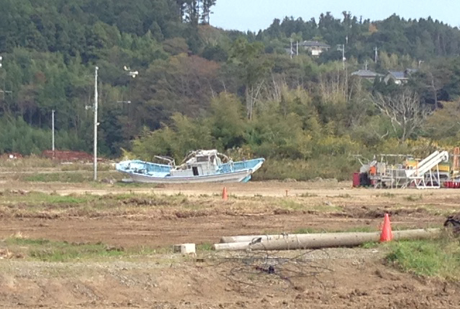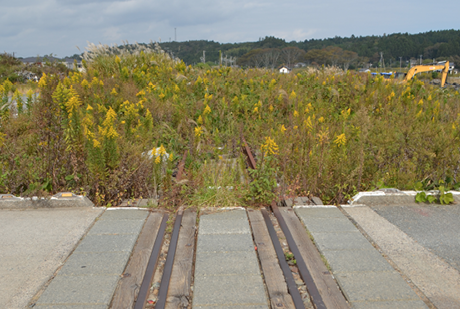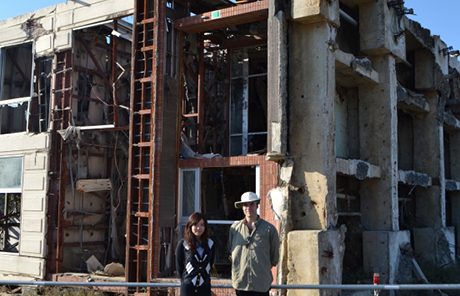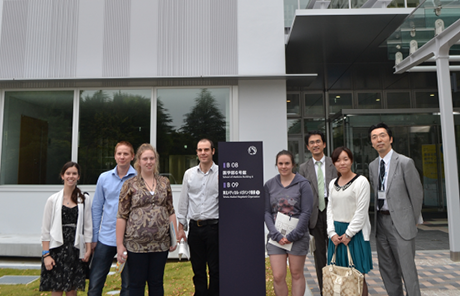
A key focus of the study of community, environmental and organisational psychology at the University of Tasmania is disaster risk reduction (DRR) originating from research into disaster recovery in the Asia Pacific region. Introducing students to cross-cultural aspects in this field is an important component of their study. It develops an understanding of the many ways DDR and recovery are conceptualised and implemented. In addition, higher-level education could provide opportunities for inter-cultural learning and experience in an increasingly interconnected world.
The New Colombo Plan Scholarship Program1 was established to promote relationships between Australia and countries and institutions in Asia. Using this scholarship, the University of Tasmania sent four undergraduate psychology students for a three-week period in October 2014 to the University of Tsukuba in Japan to study disaster mitigation and management. Japan, by its very geography, is vulnerable to extreme natural events and a written history concerning disasters dates back almost one thousand years (Kitahara 2006). This long experience with natural events, disaster management and recovery, including the 2011 Great East Japan Earthquake where fire, flood and nuclear meltdown after a tsunami was experienced, makes Japan a highly appropriate country for academic study.
In 2011 large areas of north-eastern Japan were hit by the tsunami; however, it was the nuclear reactor accident in Fukushima that has created an ongoing disaster. Technical accidents can be particularly stressful for communities because of the aftermath of unresolved environmental toxicity (Cline et al. 2010, Bonanno et al. 2010, Freudenburg & Jones 1991, Marshall & Picou 2008, Picou 2009, Shultz et al. 2011). The study tour began in the coastal area including Iwaki and the smaller towns of Tomioka, Hirono and Kokonaraha closer to the reactor. These were guided by Ms Suzuki Rieko, a geriatric psychiatric nurse from Iwaki.
Iwaki, the second largest city in northern Japan by population, lost most of its oceanfront to the tsunami and many businesses relocated to temporary shopping districts that had been established throughout affected areas in order to provide sources of income. Initially, the 30 km exclusion zone from the nuclear reactor plant extended into city limits and half the city population was evacuated. Now, four years after the event, in addition to those residents who have returned, over 24 000 evacuees from the continuing 20 km exclusion zone reside in 3 500 prefabricated houses, apartments, and public housing blocks that are still in force. While re-establishing community is a priority among survivors (Tatsuki & Hayashi 2001) it is difficult to achieve since the maximum stay in this area is two years.

This deserted boat remains stranded in Tomioka.
Students stayed at a traditional inn in Iwaki. Other hotels still mainly accommodate workers doing repair work. Among the communities ordered to leave, many fled northwest (where wind carried the radiation). The inn owner and Ms. Suzuki spoke of the difficulty experienced in re-establishing industries such as fishing and farming. Research has shown the loss of natural economic resources is a potential stressor (Hobfoll 1989). The farming of cotton, instead of rice, to reduce soil salinity shows adaptability and innovation in this situation.

Railway tracks to Tomioka Station, Fukushima are unused.
The towns of Tomioka, Kokonaraha and Hirono, skirting the exclusion zone towards the ocean, are still largely deserted. To discourage looting, the through-road is closed at night and patrolled by police. Tourism and visits to sites like a large dosimeter (a device that measures exposure to radiation) next to Kokonaraha town hall, have become an important economic activity. Pocket dosimeters are common and area readings are printed in the daily newspaper. Access to this data seems to allay some concerns about environmental safety. Ms. Suzuki said all foods—rice, vegetables and fish—are tested and can be traced to points of origin.

Visits to sites like this large dosimeter next to Kokonaraha town hall, contribute to the local economy.
It will be interesting to see how the current situation is seen in the context of the disaster itself; i.e. whether there is a positive or negative outcome. Positive and negative outcome expectancies refer to individual beliefs regarding how an event will impact a person (Paton, Burgelt & Pryor 2008). Many causes of mental stress from situations of environmental contamination have been studied, but others unique to Fukushima have emerged. For example, before the disaster wild boar were hunted to cull populations and reduce attacks on food crops. The meat was sold to specialty restaurants. Contamination has made this food source unsalable and carcass disposal problematic. As a result, the wild boar population growth has caused difficulties for local farmers who experience increased crop damage and the federal government has been requested to assist with wild boar disposal (Asahi Shinbun Evening Edition 2015). These kinds of specific situations create certain dependencies in the area and could benefit from detailed study into how they determine the level of future engagement in DRR.
In Tokyo museums and learning centres serve preserve information about past events. The students visited these facilities to explore the educational, cultural and historic aspects of disaster. The Edo-Tokyo Museum and nearby Yokoamichô Park exhibit two modern disaster events: the 1923 Tokyo earthquake and Tokyo air raids at the end of World War II. The main cause of mortality in both events was fire and its effects on humans. How fire can affect the material environment features prominently in the displays.

Memorial at Yokoamichô Park for victims of the 1945 air raid on Tokyo.
The ‘ground level’ similarity of these events informs perception in that both are termed ‘disasters’ (the ideogram sai 災) although one is ‘natural’ (shinsai 震災 ‘earthquake disaster’) and the other is literally ‘war-related’ (sensai 戦災). This conflation of disaster events is reinforced by a monument to the air raid victims built in 2001 at Yokoamichô Park beside the earthquake museum. Beside this monument is a small cenotaph to Korean residents killed by mobs during post-earthquake riots.
At these exhibits it is possible to see elderly visitors who experienced the events as children. At the Edo-Tokyo Museum a passer-by, hearing the students speak English, approached the group and candidly told of family members who died in the raids and how his children and grandchildren now lived in the US. These impromptu meetings demonstrate the many complex experience of disaster in Japan.
Future preparedness for disaster is offered at the Honjô Life Learning Center run by the Tokyo Fire Department. These learning centres are popular with primary-level school tour groups and help to develop individual competencies, which are linked with more collective efficacy in Japan (Paton et al. 2010). The technology level of demonstrations was very high. For example, the earthquake simulator chamber controls were pre-programmed to mimic seismic intensities and rhythms of specific events (e.g. in Kobe, Niigata-Chuetsu and Miyagi). Since familiarity with natural hazards is linked to preparation (Paton 2008), such demonstrations improve interpretation of information and also empower communities (Paton et al. 2008). Other simulations included a hurricane tunnel and an area where people can practice using a fire extinguisher. A retired fireman acted as guide and answered student questions from his first-hand experiences.

The hurricane tunnel in the Life Learning Center, Tokyo gives visitors an experience of high wind speeds.
Ishinomaki and Sendai in Miyagi Prefecture were also visited. The epicentre of the 2011 earthquake was off the coast but the topography of this area focused and intensified the effect of the resulting tsunami. The Onnagawa region, north of Ishinomaki, was profoundly affected with water levels rising above 16 metres. As a result, a four-story concrete structure was upended and displaced, railway cars were deposited on mountains, and the local hospital on a mountain overlooking the harbour was flooded. Local taxi tours of the area provide a unique perspective of the physical and emotional experiences of witnessing such a disaster.

This four-story building in Onnagawa, Miyagi, was upended by the 2011 tsunami.
Interestingly, a possible fire catastrophe was unintentionally averted. There is a large natural gas facility beside the river inlet that divides the coast closer to the Ishinomaki city center. Although seafood factories on the opposite side were heavily damaged, the bridge became an unintended breakwater for the tsunami, protecting the gas facility. This is known as ‘unplanned functioning’. Usually, infrastructure malfunction can result in technical disaster (Edelstein 2004). However, in this instance, unplanned functioning prevented further disaster. This example demonstrates the unknown variables in environmental risk management.
Visiting Ishinomaki and the prefectural capital, Sendai, allowed the group to observe the different ways of rebuilding community, capacity and knowledge. The non-government organisation, Save the Children Japan, voiced the concerns of parents to local government to fund a new children’s recreation centre in Ishinomaki. The staff were proud to say design elements for the structure came from the children themselves.

Examining photos of the flooded areas taken by the taxi driver (r.) on the hilltop hospital overlooking Onnagawa.
The group also visited the new International Research Institute of Disaster Science (IRIDeS) and Megabank at the University of Tohoku in Sendai. In Japan, national universities act as government research centres and this large-scale public investment is to advance knowledge for future disaster policy. The IRIDeS combines multi-disciplinary approaches including engineering, social science, and information management. The Megabank is a biomedical research centre conducting a 10 000-subject longitudinal study investigating the multi-generational effects of the disaster over several decades. The tour of these facilities concluded with a seminar hosted by staff at the Megabank faculty organised the UN Office for Disaster Risk Reduction Conference in Sendai in 2015.

The staff from Miyagi Megabank, Tohoku University with the students in the tour group.
This visit allowed students to meet experts in disaster risk reduction and recovery and see how theory and practice in these areas has developed in Japan. It also increased the appreciation of the long-term nature of disaster recovery and how psychologists can complement the activities of other professionals. Research models show that personal, civic and organisational levels are the mediating factors that affect people’s responses to hazards. Looking at Japan, history and culture could certainly be added. Overall, a study tour of this country in this area reveals the interdependency of these elements.
The challenges with post-disaster decision-making are also apparent. Large top-down initiatives such as the Tohoku University research facilities show high efficiency in administering resources. Community-level initiatives, such as the children’s community centre, also have positive outcomes. However, tour guides stressed the issue of changing demographics exacerbated by the disaster. When younger families choose not to return many elderly family members become isolated. Lack of privacy in temporary housing and future uncertainty has caused emotional stress. Therefore, mental health care needs increase even with reduced capacity due to tsunami-damaged medical facilities (Zhang et al. 2014). Looking comparatively at disaster preparedness based on culture (Paton et al. 2010), place and livelihood, attachments can inform the adaptive capabilities of communities. It is clear when visiting temporary housing that differences exist not only between communities, but also within communities and between generations. Japan-based documentary filmmaker and music producer, Jeffrey Jousan, recorded the struggle of displaced small-scale agriculturalists and the elderly that highlights the importance of community participation in creating empowerment (J. Jousan, personal communication, 25 October 2014).
As disaster study becomes a more comprehensive field, the competencies will become better structured. Undergraduate programs can send students overseas as part of their coursework to partner universities. Japan is an ideal country for study in emergency management and disaster recovery areas.
Asahi Shinbun Evening Edition 2015, Fukushima Exclusion Zone Wild Boar Cannot Be Eaten, Disposed of: Federal Government Considers Action (in Japanese), p. 10. At: www.asahi.com/articles/DA3S11618970.html.
Bonanno G, Brewin CR, Kaniasty K & La Greca AM 2010, Weighing the Costs of Disaster: Consequences, Risks, and Resilience in Individuals, Families, and Communities. Psychological Science in the Public Interest, 11(1), pp. 1–49.
Cline RJW, Orom H, Berry-Bobovski L, Hernandez T, Black CB, Schwartz AG & Ruckdeschel JC 2010, Community-Level Social Support Responses in a Slow-Motion Technological Disaster: The Case of Libby, Montana. American Journal of Community Psychology, 46, pp. 1–18.
Edelstein MR 2004, Contaminated communities: Coping with residential toxic exposure, Westview Press Cambridge, MA.
Freudenburg W & Jones T 1991, Attitudes and Stress in the Presence of Technological Risk: A Test of the Supreme Court Hypothesis. Social Forces, 69(4), pp. 1143–1168.
Hobfoll SE 1989, Conservation of Resources: A New Attempt at Conceptualizing Stress. American Psychologist, 44(3), pp. 513–524.
Kitahara I 2006, Disasters in Japan: A History (in Japanese), Yoshikawa Kobunkan.
Marshall BK & Picou JS 2008, Worst Cases: The Challenge of Twenty-First Century Catastrophes. Sociological Inquiry, 78(2), pp. 230–247.
Paton D, Bajek R, Okada N & McIvor D 2010, Predicting community earthquake preparedness: a cross-cultural comparison of Japan and New Zealand. Natural Hazards, 54(3), pp. 765–781.
Paton D 2008, Risk communication and natural hazard mitigation: how trust influences its effectiveness. International Journal of Global Environmental Issues, 8(1), pp. 2–16.
Paton D, Gregg CE, Houghton BF, Lachman R, Lachman J, Johnston DM & Wongbusarakum S 2008, The impact of the 2004 tsunami on coastal Thai communities: assessing adaptive capacity. Disasters, 32, pp. 106–119.
Paton D, Burgelt P & Prior T 2008, Living with bushfire risk: Social and environmental influences on preparedness. Australian Journal of Emergency Management, vol. 23, no. 3, pp. 41–48.
Picou J 2009, Katrina as a Natech Disaster: Toxic Contamination and Long-Term Risks for Residents of New Orleans. Journal of Applied Social Science, 3(2), pp. 39–55.
Shultz JM, Kelly F, Forbes D, Verdeli H, Leon GR, Rosen A & Neria Y 2011, Triple Threat Trauma: Evidence-Based Mental Health Response for the 2011 Japan Disaster. Prehospital Disaster Medicine, 26(3), pp. 141–145.
Tatsuki S & Hayashi H 2001, Seven Critical Element Model of Life Recovery: General Linear Model Analyses of the 2001 Kobe Panel Survey Data. In Proceedings of 2nd workshop for comparative study on urban earthquake disaster management, pp. 14–34.
Zhang H, Yan W, Oba A & Zhang W 2014, Radiation-driven migration: the case of Minamisoma City, Fukushima, Japan, after the Fukushima nuclear accident. International Journal of Environmental Research and Public Health, 11(9), pp. 9286–305. At: www.pubmedcentral.nih.gov/articlerender.fcgi?artid=4199020&tool=pmcentrez&rendertype=abstract [14 December 2014].
Dr Adam Lebowitz has lived in Japan for over 20 years. He completed his doctorate on social support and mental health in post-disaster communities at the Graduate School of Comprehensive Human Sciences, University of Tsukuba, Japan.
Kelsea Clingeleffer, Liana Riddington, Zara Hoare, and Warde Macintosh are undergraduates in the School of Medicine (Psychology), University of Tasmania.
1 New Colombo Scholarship Plan. At: http://dfat.gov.au/people-to-people/new-colombo-plan/scholarship-program/Pages/scholarship-program.aspx.